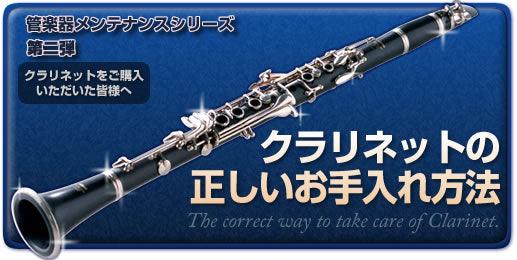
Thank you for purchasing a clarinet from Okubo Wind Instruments. Proper daily care is essential for an enjoyable clarinet life. Here we summarize how to assemble your instrument and how to take care of it on a daily basis.
Red partare points that require special attention. Please read through them before using the instrument!

How to assemble the clarinet
Wash your hands clean before touching the instrument. If there is no washroom nearby, wipe perspiration off your palms thoroughly with a wet wipe or handkerchief. Sweaty hands are not only a source of dirt on the windpipe and damage to the plating, but can also cause key failure.

Apply a small amount of cork grease to the joint cork of each tube, rubbing it in with your finger.

The amount of cork grease to be applied should be just enough so that it does not stick out when the joint is made. It is not necessary to apply a lot of grease.
While the cork is still new, apply the grease every time so that the grease can be blended.

|
|
|
|
|
When assembling the lower tube and bell, and the upper tube and barrel,When assembling the lower tube and bell, and the upper tube and barrel, do not apply strong force to the key (circled area in the photo). |
|
|
|
|
|
|


|
|
|
|
|
When assembling the lower tube and bell, do not exert any strong force on the key (circled area in the photo). Make sure that the ring key lifts up when you press the ring key. |
|
|
|
|
|
|
|
With your other hand, lightly grip the joint between the lower pipe and the bell (the part with the smallest key),Make sure that the joint between the upper and lower pipes does not collide with each other.Assemble the bell with care so that the joints between the upper and lower pipes do not collide. If you assemble the bell while turning it in a large circle, the keys will collide with each other, causing it to bend and lose its balance. |
|
|
|
|
|
|


Assemble the mouthpiece and barrel.
Insert the ligature into the mouthpiece first, and then put a moistened reed between the mouthpiece and ligature.from the top.Insert the moistened reed between the mouthpiece and the ligature.
When looking at the reed from the front, the tip of the mouthpiece is slightly above the tip of the reed.
(about a hair!) above the tip of the reed. Set it where you can see the tip of the mouthpiece slightly above the tip of the reed (about a hair's breadth!).

After playing

Loosen the ligature screws and remove the reed, ligature, and mouthpiece in that order.

|
|
|
|
|
Put a clarinet-size swab through the ligature. Do not use an incorrectly sized swab as it may cause clogging. You can use the swab from either the bell or the barrel, but be careful when using the barrel because the entrance is narrow! |
|
|
|
|
|
|

If you are using a mouthpiece, please wipe the mouthpiece gently with a gauze or a swab for mouthpieces.
Please replace the swab with a new one on a regular basis.
If you use a swab with frayed threads after repeated washing, not only will the fibers remain in the tone holes, but they may also cause the swab to clog.

|
|
|
|
|
Disassemble in the reverse order of assembly.
Wipe off any moisture on the inside of the barrel and the joint cork part with a tissue. It is sufficient to wipe off the cork grease lightly.Do not wipe off the cork grease with a swab! |
|
|
|
|
|
|

|
|
|
|
|
Clean the tampo with cleaning paper. Insert the cleaning paper between the tampo and the tone hole, and move the key several times by flapping it. At this time,Do not pull the cleaning paper.The cleaning paper will tear off and stick to the tampo. |
|
|
|
|
|
|
Cleaning paper with powder on it is sold, but we do not recommend it.
Even if the stickiness stops temporarily, the powder left on the tampo will attract moisture and dirt, shortening the life of the tampo and causing it to go out of adjustment.

|
|
|
|
|
Wipe the instrument with a soft, clean cloth. It is sufficient to gently wipe off sweat and fingerprints on the key parts as well. |
|
|
|
|
|
|

Place the instrument gently in a case that fits the size of the instrument. If there is any rattling between the instrument and the case, the instrument will be subject to vibration during transportation, which may cause it to go out of adjustment.
Moisture and excessive humidity are the clarinet's worst enemies.Swabs should not be stored in the same case as the instrument, but should be kept separately from the instrument by placing them in the case cover.Swabs should not be stored in the same case as the instrument.
Do not close the case with sheet music or other objects on top of the instrument. Doing so may distort the keys and cause imbalance.
●Be careful not to forget to close the zipper and clasp of the case!Make it a habit to close the zipper and clasp as soon as you put the instrument in the case!

The clarinet's windpipe is prone to cracking due to sudden changes in temperature and humidity. Avoid playing clarinets outdoors in mid-summer or mid-winter, or even indoors in direct sunlight or near air conditioners.
For new instruments, you should avoid playing for a long period of time for about a month after purchase.For used instruments that have been played for a certain period of time, the risk of developing new cracks is much lower, though,Since they may have been in storage for a long time, please treat them as you would a new instrument.Initially, do not blow for more than 30 minutes a day in a row.Swabs should be passed through once every 15 minutes or so during the performance.
After playing, be sure to wipe off all moisture and put the swab back in the case.
If the wood was originally made of wood that is prone to cracking, it may not be possible to prevent cracking.

When you are away from the instrument, please put the swab through the instrument and put the instrument back in its case. When you are away from the instrument, please put the swab through the instrument and put the instrument back in the case.
Do not leave the instrument unprotected with water.
How was it?
These are the basic care instructions for clarinets.
Even though you know how to take care of your clarinet, you tend to skip taking care of it. Do you ever do that?
With daily maintenance, your clarinet will last longer and cost less to have it adjusted. And you can save on the cost of adjustments.
Learn how to take care of it properly and enjoy playing.



